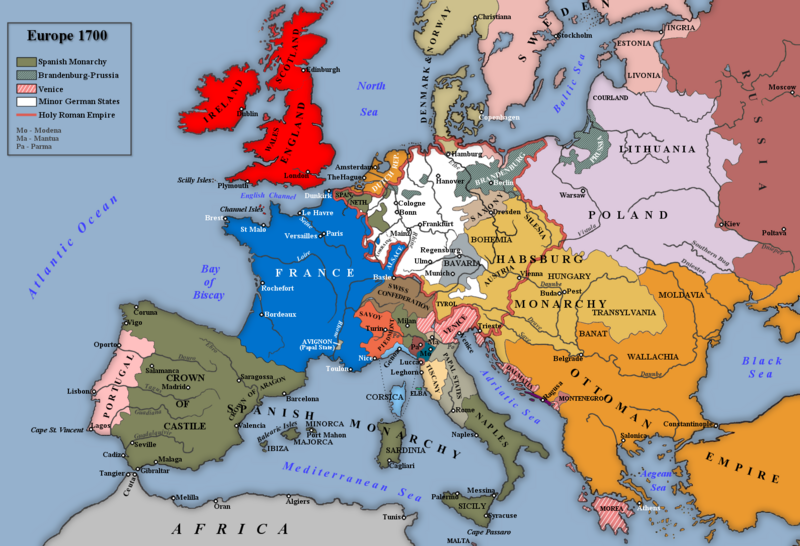The period from 1600-1800 witnessed a transformation in ideas about basic human rights, the government and politics more generally and a new scientific outlook. Even the food people ate quickly changed. Most perspectives remained local since people lived in small villages, but the world became increasingly global with new trade routes, an integrated Atlantic economy (but expanding to Asia), and the mass movement of people, often forced, worked to transform the world.

Figure 2: Europe in 1648

Figure 3: Europe 1700
Chaos plagued much of the first half of the 17th century. New disputes between Catholics and Protestants combined with old disputes over territory and the desire to control resources to make wars more personal. These disputes were more devastating and on a larger scale than in the past. The 30 Years War (1618-48) witnessed a shifting alliances, and 20 different European states fighting each other in Germany. Mercenary armies lived off the land, destroyed crops, and plundered and leveled villages. The effects were the dislocation and disruption to the local population with death rates, in some years, exceeding that of the Black Death. France also witnessed its own religious wars slightly earlier (1562-1598) that caused the death of up to three million people due to famine, violence or disease as the country emerged out of a period of civil unrest. The English Civil War (1642-51 and 1648-51) witnessed supporters of Parliament fighting the British king. The war ended as Oliver Cromwell led a successful revolt to overthrow Charles I.
Other major, long-term events included a variety of issues that generally hurt the lives and living conditions of the poor. Issues surrounding food production drove up prices and hurt the overall diets of people until the arrival of new crops from the Americas later in the century. The European population recovered from the Black Death, and the demand for workers generally never met the supply. Workers’ wages generally remained stagnant or decreased, forcing more of the population to join the class of destitute that focused on daily survival. The increasing rise in population, especially after 1650, did little to help this trend. The nobility and other owners of the land took advantage of the high prices to further their positions in society. There was a divide occurring within Europe as well. Northwest Europe (especially Holland and Britain) began to differ from other European countries (especially those in southern and eastern Europe). Holland and Britain slowly started to industrialize, possessed more towns, higher rates of literacy and less censorship than others with lower life expectancy, a continuation of feudalism (especially in czarist Russia), fewer towns, and higher rates of poverty. Britain and Holland began developing a public sphere — a place in between the world of the state and private world of the family/household — where ideas, like the role and character of the state, could be debated. Business was also conducted in the public sphere. Increasingly, access to the public sphere required an education, so educational institutions — schools and universities — developed during this period.
The European continent was divided by religion too. Protestants and Catholics had specific areas. At the same time, there was also a growing trend of secularization — again, more in Northern Europe — but the Catholic Church remained strong and experienced a revitalization in places such as Spain. The state also grew in size, scope, and power. Still, it was possible to overthrow the state through revolution, but the state now possessed increasingly large armies (different than police forces) and needed to sustain this army through taxes.
Candela Citations
- Europe map 1648. Authored by: Raderich. Provided by: Wikimedia Commons. Located at: https://upload.wikimedia.org/wikipedia/commons/d/d0/Europe_map_1648.PNG. License: CC BY-SA: Attribution-ShareAlike
- The Coronation of Napoleon, 1805-1807. Authored by: Jacques-Louis David. Provided by: Wikimedia Commons. Located at: https://upload.wikimedia.org/wikipedia/commons/1/1e/Jacques-Louis_David_-_The_Coronation_of_Napoleon_%281805-1807%29.jpg. License: Public Domain: No Known Copyright
- Europe, 1700-1714. Authored by: Rebel Redcoat. Provided by: Wikimedia Commons. Located at: https://upload.wikimedia.org/wikipedia/commons/f/fc/Europe%2C_1700%E2%80%941714.pnghttps://upload.wikimedia.org/wikipedia/commons/f/fc/Europe%2C_1700%E2%80%941714.png. License: CC0: No Rights Reserved
